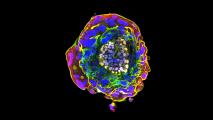Getting a new drug approved by the FDA can take over a decade and cost hundreds of millions, if not billions, of dollars. Much of that time and cost goes toward the meticulous process of showing the drug is safe.
Some scientists are hoping to streamline this process by discovering unknown therapeutic activity in drugs that are already FDA approved. “Repurposing” drugs in this way can reduce the cost and time for new treatments to reach the market, as it is not necessary to demonstrate safety rigorously a second time. The best-known example of drug repurposing is sildenafil (Viagra), which was originally used to treat high blood pressure and angina, until it was shown to have highly marketable side effects.
Repurposing Prozac
A new study from the University of Virginia School of Medicine suggests fluoxetine (Prozac) could be repurposed to prevent age-related macular degeneration (AMD), which is the leading cause of irreversible blindness among those over age 50 and affects an estimated 200 million people worldwide.
Those who suffer from AMD experience slow vision loss due to the death of retinal cells. This death is driven in part by the accumulation of RNA transcripts of Alu elements, segments of DNA that were once considered “junk” but have been shown to contribute to biological functions and diseases. As Alu-encoded RNA moleculesbuild up in a cell, they set off a “danger alarm.” This signals to the cell that it is unhealthy, and it initiates a cascade of events that lead to the cell’s death. Despite dozens of clinical trials, no treatment has yet proven effective at stopping this process.
When the research team began their hunt for a drug to repurpose, they did not examine every FDA approved drug (which number about 1,300). Instead, they looked for approved drugs that were structurally similar to a specific small molecule, CY-09, which prevents the danger alarm from sounding. They found that CY-09 and fluoxetine share a molecular structure: a (trifluoromethyl)phenyl branch.
From form to function
It is not enough to show that fluoxetine shares a structure with a molecule that blocks the danger signal; the researchers also needed to illustrate that fluoxetine treatment can prevent cell death under the conditions that lead to AMD — that is, when Alu-encodedRNA transcripts build up in retinal cells.
The group injected these RNA molecules directly into the eyes of mice in both the control and treatment groups. As expected, this caused the retinal cells to die in the control mice. However, the retinal cells of mice that were treated with fluoxetine remained healthy.
Prozac appears to prevent blindness in humans
Next, the researchers sought to determine if using fluoxetine would prevent the development of AMD in humans. Normally, it takes years before a new drug can be approved for human testing. However, there are already millions of Americans taking fluoxetine.
The team of researchers studied two health insurance databases containing data on over 100 million Americans. They found that patients who were taking fluoxetine were 15 percent less likely to develop AMD than patients who were not. This discovery is important for the drug development pipeline, as it further bolsters confidence in a successful market release.
Given that fluoxetine has already been shown to be safe in humans, the researchers hope these findings will allow them to quickly begin performing randomized controlled trials of fluoxetine for the treatment of AMD.
This article was reprinted with permission of Big Think, where it was originally published.






